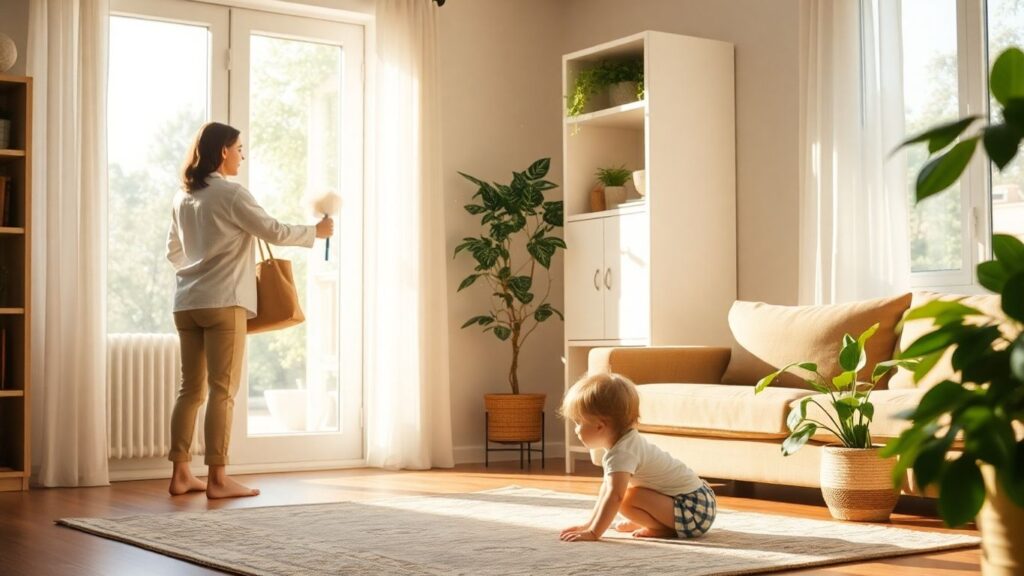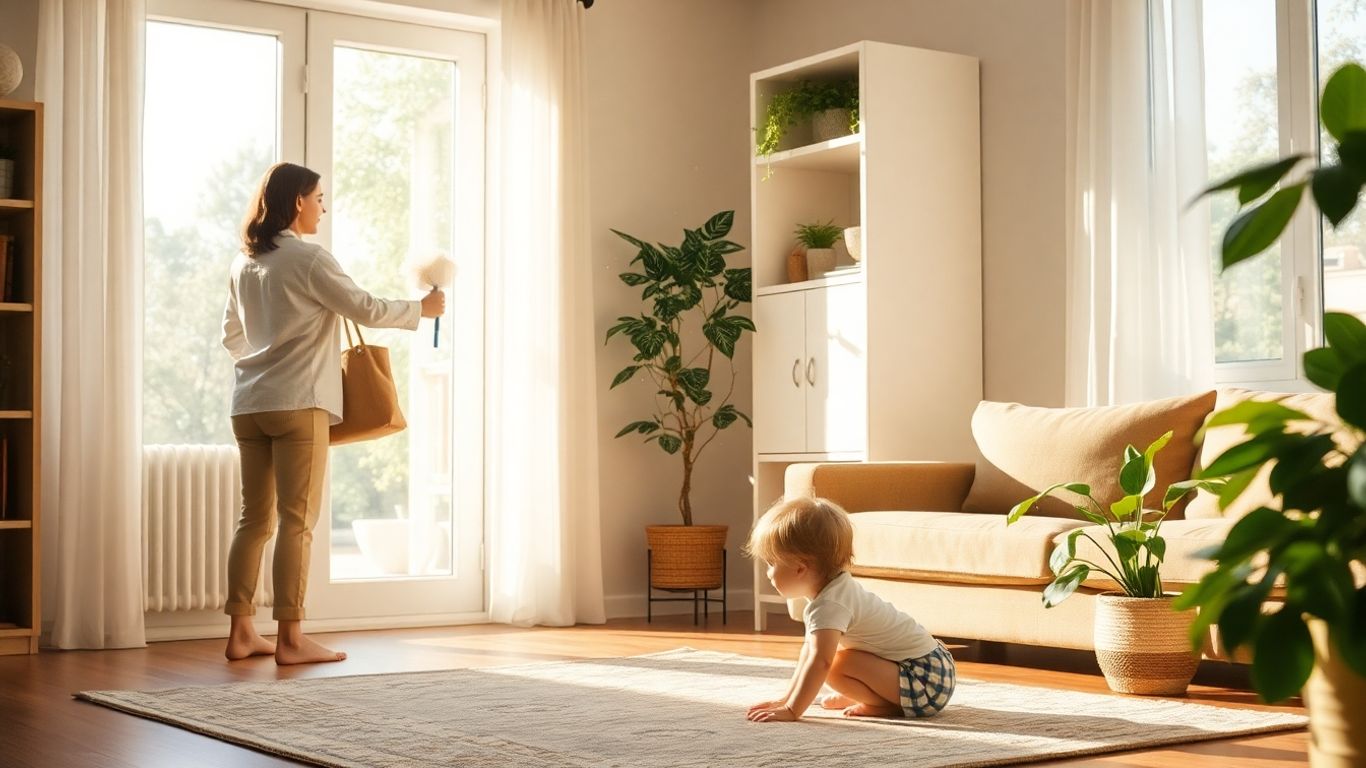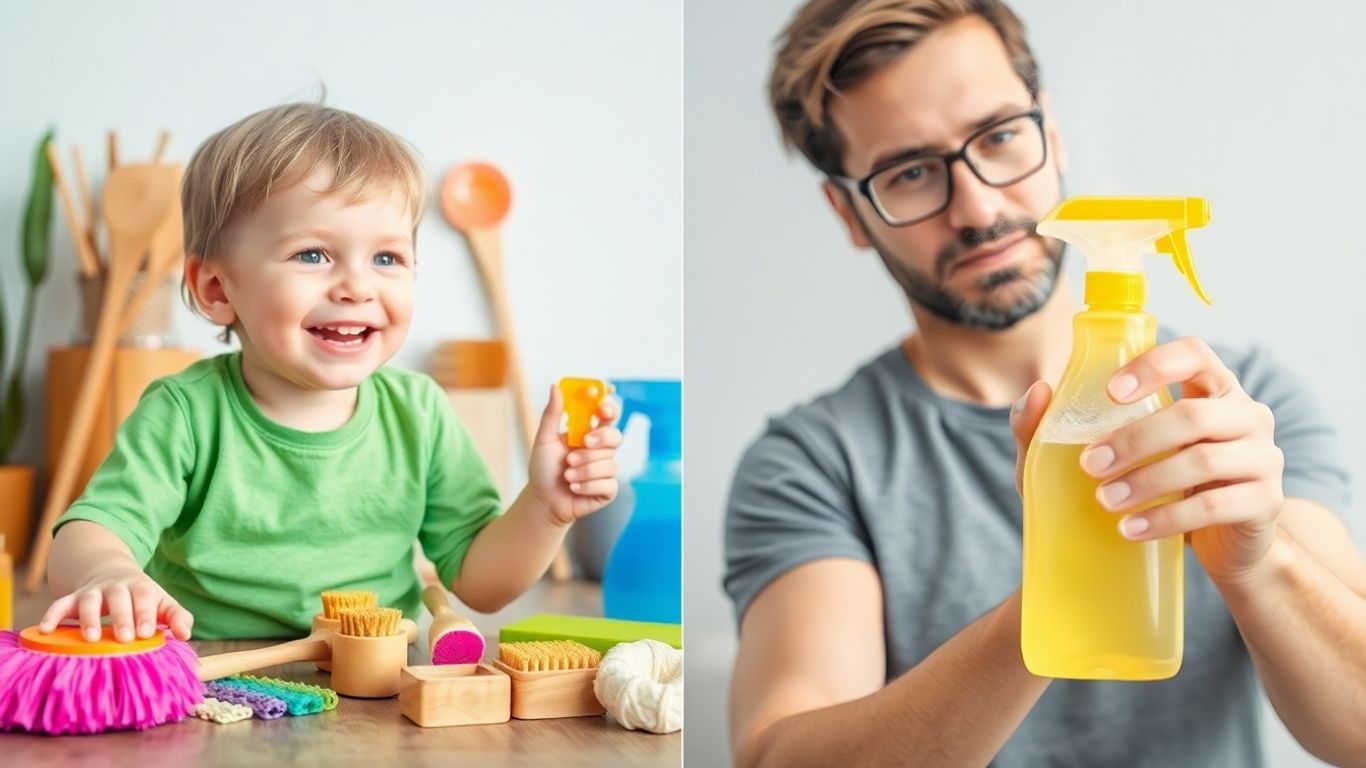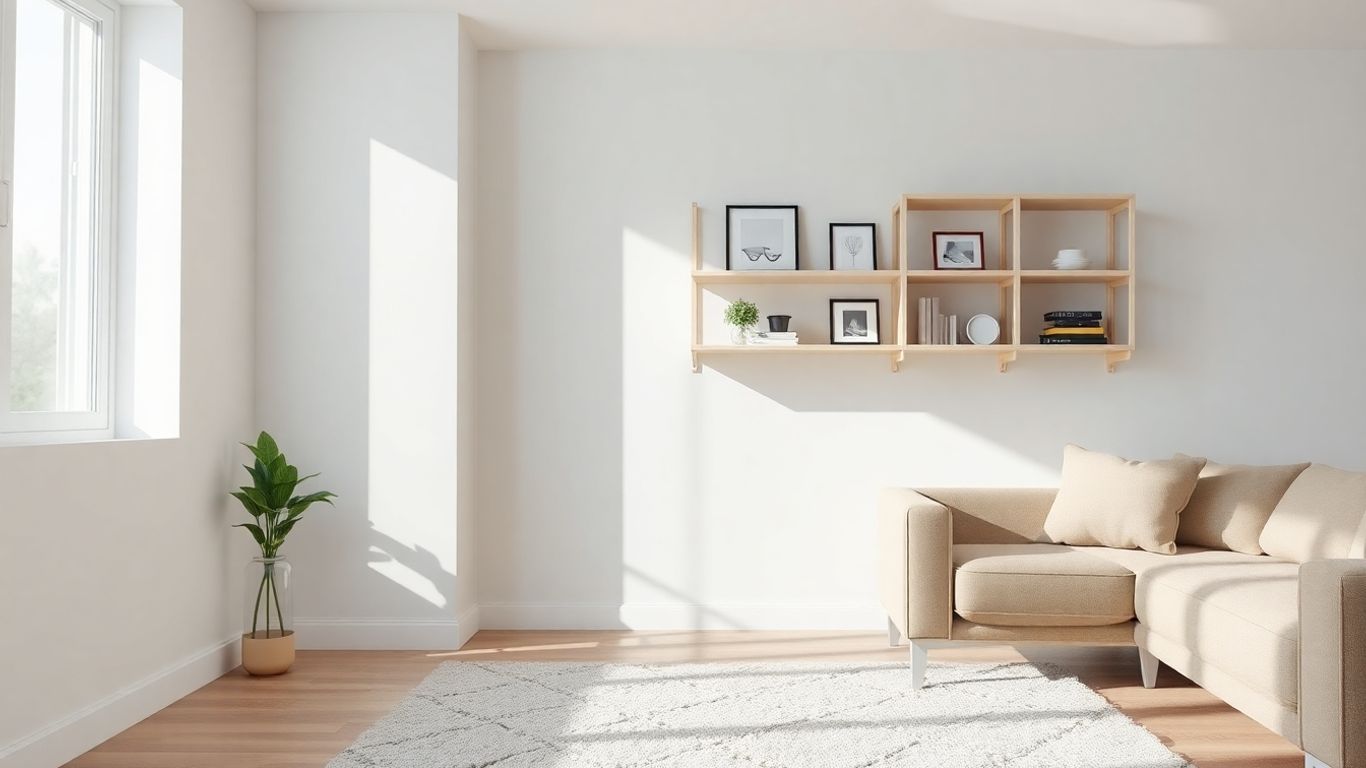You know, we spend a lot of time indoors, right? And while our homes are supposed to be safe havens, the air we breathe inside can sometimes be worse than what’s outside. It’s pretty wild when you think about it. Dust, pet dander, little bits of who-knows-what – it all adds up. This is where regular cleaning really steps in, not just for looks, but for making the air you and your family breathe a whole lot better. Let’s talk about how keeping things tidy can actually help you feel better.
Key Takeaways
- Regular cleaning gets rid of dust, pet dander, and pollen that can make allergies and asthma flare up.
- Dust mites, tiny critters that live in our homes, are reduced by frequent vacuuming and dusting, which helps with breathing.
- Keeping moisture down and cleaning regularly helps stop mold and mildew from growing, which is good for your lungs.
- Using safer cleaning products and airing out your home when you clean cuts down on chemicals you might breathe in.
- A cleaner home means fresher air, less stress, and a generally healthier and happier family environment.
Breathe Easier With Regular Cleaning
You know that feeling when you walk into a house that just smells clean? It’s more than just a nice scent; it’s a sign of a healthier environment. Our homes can actually trap a lot of stuff in the air that we don’t even see. Think dust, tiny bits of skin, pet dander, and even microscopic mold spores. All of this can really mess with how well we breathe, especially if anyone in the family has allergies or asthma.
Understanding Indoor Air Pollution
Indoor air pollution is a big deal, and it’s not just about what you can see. Pollutants can come from all sorts of places: the cleaning products we use, furniture off-gassing chemicals, cooking, and even just everyday living. These particles and gases can hang around in the air for a long time, and when we breathe them in constantly, it can lead to all sorts of issues, from headaches and fatigue to more serious respiratory problems over time. It’s kind of like living in a bubble of not-so-fresh air without even realizing it.
The Impact of Hidden Contaminants
What’s really sneaky about indoor air pollution is how many contaminants are hidden. Dust mites, for example, are tiny creatures that live in our carpets, bedding, and upholstery. They feed on dead skin cells and their waste products are a major trigger for allergies and asthma. Then there’s pollen that gets tracked in from outside, and pet dander, which is basically tiny flakes of skin shed by our furry friends. Even if you vacuum regularly, these microscopic troublemakers can still be lurking, impacting the air quality in your home.
Why Surface Cleaning Isn’t Enough
Sure, wiping down counters and sweeping the floor makes a house look and feel cleaner. But when it comes to air quality, just cleaning the surfaces often doesn’t cut it. Many of the particles that affect our breathing are so small they get embedded deep into carpets, upholstery, and even curtains. Standard cleaning methods might miss these. To truly improve your indoor air, you need to tackle these hidden pollutants that are circulating in the air we breathe every day. It’s about getting to the root of the problem, not just the visible mess.
The air inside our homes can sometimes be more polluted than the air outside. This is because pollutants get trapped indoors and can build up over time, especially in well-sealed, energy-efficient homes. Regular cleaning helps to remove these trapped particles, making your home a healthier place to live.
How Regular Cleaning Tackles Allergens And Irritants
You know, sometimes it feels like no matter how much you tidy up, there’s still that underlying stuffiness in the air. That’s often because the real culprits aren’t always visible. Regular cleaning is your secret weapon against a whole host of tiny troublemakers that can really mess with your breathing.
Reducing Dust Mite Populations
Dust mites. Ugh. These microscopic critters love to hang out in our beds, carpets, and upholstery. They’re a major trigger for allergies and asthma, and honestly, the thought of them makes my skin crawl a little. The good news? Consistent cleaning, especially vacuuming with a good filter and washing bedding frequently in hot water, can really cut down their numbers. It’s not about getting rid of every single one – that’s pretty much impossible – but about keeping their population low enough that they don’t cause problems.
Banishing Pet Dander and Pollen
If you have furry friends, you know they bring a lot of love… and dander. Pet dander, along with pollen that drifts in from outside, are like little airborne irritants. They stick to everything – furniture, clothes, and yes, your lungs. Regular dusting, vacuuming, and wiping down surfaces helps to remove this stuff before it builds up and gets recirculated. Think of it as giving your home a regular refresh, so your pets can be part of the family without making breathing a chore.
Preventing Mold and Mildew Growth
Nobody wants mold. It’s not just unsightly; those spores can cause all sorts of respiratory issues and allergic reactions. Mold loves damp places, like bathrooms, kitchens, or anywhere there might be a leak. Keeping things clean and dry is key. This means wiping down shower walls, fixing leaky faucets promptly, and making sure areas like under the sink are aired out. Good ventilation is a huge part of this – opening windows when you can, and using exhaust fans. It’s a constant battle, but a necessary one for healthy air.
Keeping on top of these common allergens isn’t just about a cleaner-looking house; it’s a direct investment in making sure everyone in your home can breathe more comfortably. It’s about creating a sanctuary, not a source of sniffles and sneezes.
Here’s a quick rundown of what regular cleaning helps with:
- Dust Mites: Reduced populations through frequent vacuuming and washing fabrics.
- Pet Dander: Wiped away from surfaces and fabrics, preventing buildup.
- Pollen: Removed from floors and furniture before it becomes airborne.
- Mold & Mildew: Prevented by keeping damp areas clean and dry, and ensuring good airflow.
Improving Respiratory Health Through Cleaning
Ever feel like you’re just not breathing as easily as you should, even when you’re inside your own home? It turns out that the air we breathe indoors can really make a difference to our lungs and overall breathing comfort. Regular cleaning isn’t just about making things look tidy; it’s a direct way to help your family breathe better.
Easing Asthma and Allergy Symptoms
For many people, especially those with asthma or allergies, indoor air can be a major trigger. Dust mites, pet dander, and pollen are common culprits that get trapped in carpets, upholstery, and even settle on surfaces. When these allergens are stirred up, they can cause sneezing, itchy eyes, and for some, serious breathing difficulties. Consistent cleaning, like vacuuming with a good filter and dusting regularly, significantly cuts down on these airborne irritants. This means fewer flare-ups and a more comfortable environment for everyone. It’s amazing how much better you can feel when the air is cleaner.
Reducing Congestion and Sneezing
That stuffy nose or constant urge to sneeze might be more than just a passing cold. Indoor air pollutants, from dust to microscopic mold spores, can irritate your nasal passages and airways. Think about how much dust can accumulate in just a week! By regularly cleaning and removing these particles, you’re essentially clearing the pathways for easier breathing. This can lead to less daytime congestion and fewer annoying sneezes throughout the day. It’s a simple, practical step towards feeling more clear-headed.
Enhancing Sleep Quality
Have you ever woken up feeling a bit congested or like you just didn’t sleep well? Poor indoor air quality can actually disrupt your sleep. Breathing in irritants all night can lead to discomfort and even minor breathing pauses that you might not even notice consciously. A cleaner bedroom, free from dust and allergens, promotes better airflow and a more restful night. When you’re breathing easier, you’re more likely to get deeper, more restorative sleep. This improved rest can positively impact your mood, energy levels, and overall health the next day. If you’re looking for ways to improve your sleep, consider how clean your bedroom air is. Sometimes, just getting a professional cleaning can make a big difference in how you feel [eab5].
Keeping your home clean is a direct investment in your family’s respiratory health. It’s not just about appearances; it’s about creating an environment where everyone can breathe more freely and comfortably, leading to fewer health issues and a better quality of life.
Minimizing Chemical Exposure With Smart Cleaning
You know, sometimes I think about all the stuff we use to clean our homes. Sprays, wipes, powders… they all smell strong, right? While they might make things look shiny, many of these products release chemicals into the air that we end up breathing. This is where being smart about your cleaning routine really makes a difference for your family’s health.
The goal is to reduce the amount of volatile organic compounds (VOCs) and other potentially harmful chemicals floating around in your home’s air. These aren’t just coming from the cleaning supplies themselves, but also from things like new furniture, paints, and even air fresheners. By choosing wisely and cleaning thoughtfully, you can significantly cut down on this chemical load.
Choosing Safer Cleaning Products
This is probably the biggest step you can take. Many conventional cleaners are packed with ingredients that can irritate your lungs and skin. Luckily, there are much better options available now.
- Look for “green” or “eco-friendly” labels: While not always a guarantee, these labels often mean fewer harsh chemicals. Check the ingredient list if you can.
- DIY cleaners are your friend: Simple ingredients like vinegar, baking soda, and lemon juice can tackle a surprising number of cleaning jobs effectively. For example, a 50/50 mix of white vinegar and water in a spray bottle is great for most surfaces.
- Read the labels carefully: Even “natural” products can sometimes have ingredients you want to avoid. Pay attention to warnings and ingredient lists.
- Opt for fragrance-free: Many artificial fragrances are actually a cocktail of chemicals that can cause headaches and respiratory issues.
Ventilating During Cleaning Tasks
Even if you’re using the safest products, it’s still a good idea to get some fresh air circulating while you clean. Think of it like this: you’re opening a window for the air to escape.
- Open windows and doors, even if it’s a bit chilly outside. A few minutes can make a big difference.
- Turn on exhaust fans in the kitchen and bathroom.
- If you have a whole-house fan or an air purifier, run it while you’re cleaning.
Controlling VOCs From Household Items
It’s not just cleaning products. Many everyday items can off-gas VOCs, contributing to indoor air pollution. Being mindful of these sources can help.
- New furniture and carpets: These often release chemicals when they’re new. Air out new items in a well-ventilated space before bringing them into main living areas if possible.
- Paints and finishes: When painting, choose low-VOC or zero-VOC options and make sure the room is well-ventilated during and after painting.
- Air fresheners and candles: Many of these release VOCs. Consider natural alternatives like simmering spices or simply opening a window for fresh air.
Making small changes in the products you use and how you clean can have a big impact on the air your family breathes every day. It’s about being more aware and choosing options that support a healthier home environment without sacrificing cleanliness.
Here’s a quick look at some common cleaning product ingredients to be mindful of:
| Chemical Type | Potential Health Concerns |
|---|---|
| Phthalates | Hormone disruption, reproductive issues |
| Ammonia | Respiratory irritation, can create toxic gas with bleach |
| Chlorine Bleach | Respiratory problems, skin irritation, can create toxic gas |
| Synthetic Fragrances | Headaches, asthma triggers, skin irritation |
The Deeper Impact Of Regular Cleaning
Sure, a tidy home looks nice, but the real magic of regular cleaning goes way beyond just appearances. It’s about creating a healthier space for everyone under your roof. Think about it: when you really get in there and clean, you’re not just making things look good, you’re actively removing stuff that can make you feel yucky.
Eliminating Odors For A Fresher Home
Ever walk into a room and just feel… blah? Often, it’s the lingering smells. Food, pets, damp towels – they all leave their mark. Regular cleaning, especially tackling things like upholstery and carpets where smells love to hide, makes a huge difference. It’s not just about masking odors with sprays; it’s about getting rid of the source. This makes your home feel genuinely fresh, not just perfumed.
Creating A Calmer, More Comfortable Space
There’s something about a clean space that just feels right. It’s less chaotic, less distracting. When you’re not tripping over clutter or noticing dust bunnies in the corner, your brain can relax a bit. This calm environment can really help reduce stress and make your home a more pleasant place to just be. It’s like giving your mind a little break.
Boosting Overall Family Well-being
When the air is cleaner and the space feels calmer, everyone benefits. Kids might sleep better, and adults might feel less bogged down. It’s a subtle but significant shift. Think about it: fewer sneezes, less congestion, and just a general feeling of being more comfortable in your own home. This contributes to everyone feeling a bit happier and healthier overall. It’s a win-win for the whole family.
Advanced Cleaning Techniques For Superior Air Quality
The Power Of HEPA Filtration
Regular vacuuming is great, but sometimes it feels like it just stirs things up, right? That’s where HEPA filters come in. HEPA stands for High-Efficiency Particulate Air. These aren’t your average filters; they’re designed to trap really tiny particles that regular vacuums might just push around. Think dust mites, pet dander, pollen, and even some mold spores. Using a vacuum cleaner equipped with a HEPA filter means you’re actually removing these microscopic troublemakers from your home, not just redistributing them. It makes a noticeable difference, especially if anyone in the family has allergies or asthma.
Deep Cleaning Carpets and Upholstery
Carpets and upholstered furniture are like sponges for all sorts of things we don’t want in our air. Over time, dust, allergens, and even bacteria can get deeply embedded in the fibers. While regular vacuuming helps, it often doesn’t reach the stuff lurking deep down. Professional deep cleaning services use powerful equipment, like hot water extraction machines, that can really get into the nooks and crannies. They use special solutions that break down dirt and grime, and then the machine extracts it all, along with the trapped pollutants. It’s a much more thorough way to clean these surfaces and significantly improves the air you breathe.
Steam Cleaning For Sanitization
Steam cleaning is another fantastic method for tackling indoor air quality. The high heat of steam is brilliant for killing off germs, bacteria, and dust mites without the need for harsh chemicals. It’s especially useful for things like mattresses, children’s toys, and even grout in bathrooms where mold can start to grow. Because it uses just water and heat, it’s a really safe option for families, and it leaves surfaces not just clean, but also sanitized. It’s a powerful way to get rid of microscopic nasties that can affect your health.
When you think about cleaning, it’s easy to focus on what you can see. But the real impact on air quality comes from tackling the invisible stuff. Advanced techniques like HEPA filtration, deep carpet cleaning, and steam sanitization go beyond surface-level tidiness to remove pollutants that can really affect your family’s health. It’s about creating a truly clean environment, from the air you breathe to the surfaces you touch.
Breathe Easier, Live Healthier
So, there you have it. Cleaning your home regularly isn’t just about making things look nice. It’s a pretty big deal for the air you and your family breathe every single day. Think about it – all that dust, dander, and other stuff just hanging around. Getting a good deep clean done, especially with the right tools, really makes a difference. It’s like hitting a reset button for your indoor air. Making cleaning a regular thing, maybe even bringing in the pros now and then, is a solid way to help everyone in the house feel better and stay healthier. Your lungs will definitely thank you for it.
Frequently Asked Questions
What exactly is indoor air pollution?
Indoor air pollution refers to the tiny particles and substances that float around in the air inside your home. Think of things like dust, pet dander, pollen, mold bits, and even tiny bits of chemicals from everyday products. While you can’t always see them, they can make the air you breathe less healthy.
How does cleaning help with allergies and asthma?
Cleaning helps a lot because it removes the stuff that triggers allergies and asthma. When you clean, you get rid of dust mites, pet hair, pollen, and mold. Less of these things in the air means less chance of sneezing, itchy eyes, and breathing trouble for people who are sensitive to them.
Why is vacuuming with a HEPA filter important?
A HEPA filter in a vacuum cleaner is like a super-fine net. It traps really tiny particles, like dust mite droppings and pollen, that regular vacuums might just blow back into the air. Using one means you’re actually removing those irritants from your home, not just moving them around.
Can cleaning really make my sleep better?
Yes, it can! When your bedroom air is cleaner, with fewer dust mites and allergens floating around, you’re less likely to have a stuffy nose or cough during the night. This means you can breathe more easily and get more restful sleep.
Are all cleaning products bad for air quality?
Some cleaning products contain chemicals that can release fumes, called VOCs, which aren’t great for your air. It’s best to choose products that are eco-friendly or have fewer harsh chemicals. Also, opening a window while you clean helps let those fumes escape.
Besides health, what other benefits come from regular cleaning?
Regular cleaning makes your home smell fresher by getting rid of odors from things like pets or cooking. It also makes your living space feel more peaceful and comfortable, which can boost everyone’s mood and overall happiness.





